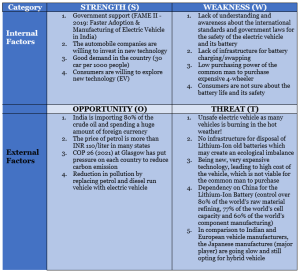SWOT Analysis (Strength, Weakness, Opportunity, Threat)


“If all you are trying to do is essentially the same thing as your rivals then it is unlikely that you will be successful” – Michael Porter
Introduction
We are always growing and changing based on our personality and life experiences. Therefore, it’s important to periodically take time out to conduct a self-analysis. Self-analyses help us to reflect on where we are in various aspects of our life. With this information, we are better prepared to make necessary adjustments as we move forward in life.
Objective
The primary objective of a SWOT analysis is to help organizations develop a full awareness of all the factors involved in making a business decision.
To run a successful business, the organization should regularly analyze their processes to ensure that they are operating as efficiently as possible. While there are numerous ways to assess the company, one of the most effective methods is to conduct a SWOT analysis.
The importance of each of the factors (Strength, Weakness, Opportunity, Threat) may be different to different kinds of industries, but any company must conduct a detailed SWOT analysis before going ahead with any business strategy.
Read More: https://bit.ly/PESTLEANALYSIS
Detailed Information
SWOT Analysis is a tool that can help the organization to analyze what their company does best right now and to devise a successful strategy for the future. SWOT can also uncover areas of the business that are holding back the organization, or that competitors could exploit if the organization don’t protect itself.
SWOT seems simple, but, if used carefully and collaboratively, it can be very revealing. Example: Pairing external threats with internal weaknesses can highlight the most serious issues a company faces.
Read More: https://bit.ly/WhatEmbeddedSoftware
Internal factors
Strengths (S) and weaknesses (W) refer to internal factors, which are the resources and experience readily available to an organization.
External factors
Opportunity (O) and Threat (T) refer to the external factors. These external factors influence and affect every company, organization and individual, it is important to note and document each one.
There are certain pertinent questions that one needs to ask while conducting this analysis, which gives an idea of what things to keep in mind. They are:
- Strength: describe the internal factors of what an organization excels at and what separates it from the competition. Like a strong brand, loyal customer base, a strong balance sheet, unique technology, and so on.
For example, For India, the huge population is a strength for domestic consumption and the same is true for any multinational company to invest in India.
- Weakness: stop an organization from performing at its optimum level. They are internal factors where the business needs to improve to remain competitive like a weak brand, higher-than-average turnover, high levels of debt, an inadequate supply chain, or lack of capital.
For Example, the poor infrastructure and bureaucracy make it difficult for any multinational company to comfortably set up and run their business in India.
- Opportunity: Opportunities refer to favourable external factors that could give an organization a competitive advantage.
For example, the ‘Make in India’ strategy of the government is creating an environment wherein domestic and international organization are setting up their manufacturing base in India just like China (Factory of the World)
- Threat: Threatsrefer to external factors that have the potential to harm an organization. Like sanctions from a rich country, bad relationships with neighbouring countries
For example, till a few years back, India was a favourite destination for the textile industry but as the overall cost is increasing, the manufacturing base has shifted to low-cost countries like Bangladesh, Vietnam etc.
Read More: https://bit.ly/WhatisCyberSecurity
When should an organization perform a SWOT analysis?
- before the organization commit to any sort of big action
- when organizations are exploring new initiatives
- revamping internal policies
- altering a plan midway through its execution
- reviewing the existing business potential and planning to grow it exponentially
Example of SWOT Analysis
The following SWOT analysis example clarifies how the four factors work and what type of information an organization should include in their analysis. This example scenario involves the ‘EV Sales in India.’

Read More: https://bit.ly/FaultTreeAnalysisFTA
Linkage with ISO 9001 and IATF 16949:
Strength (S): Clause 7.1: capabilities of its internal resources (e.g., people, the capability of equipment, organizational knowledge)
Weakness (W): Clause 7.1: any constraints (e.g., budget, number of resources, schedule)
Opportunity (O): Clause 4.1, 4.2, 6.1: understanding the organization and its context, Risk Analysis
Threat (T): Clause 4.1, 4.2, 6.1: understanding the organization and its context, Risk Analysis
Difference Between TOWS and SWOT?
A TOWS analysis is very similar to SWOT, however, there is a key difference between the two, other than a reshuffling of a few letters!
While SWOT analysis, emphasizes the internal environment (your strengths and weaknesses), TOWS forces you to look at your external environment first (your threats and opportunities).
Read More: https://bit.ly/GeneralDataPR
References:
ISO 9001: 2015
IATF 16949: 2016
IATF 16949: 2016, Sanctioned Interpretation & FAQ
Industry Experts
This is the 156th article of this Quality Management series. Every weekend, you will find useful information that will make your Management System journey Productive. Please share it with your colleagues too.
In the words of Albert Einstein, “The important thing is never to stop questioning.” I invite you to ask anything about the above subject. Questions and answers are the lifeblood of learning, and we are all learning. I will answer all questions to the best of my ability and promise to keep personal information confidential.
Your genuine feedback and response are extremely valuable. Please suggest topics for the coming weeks.

Recent Comments